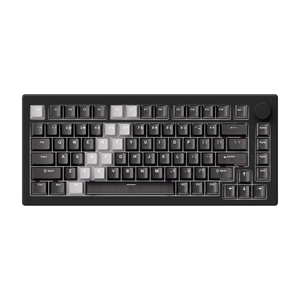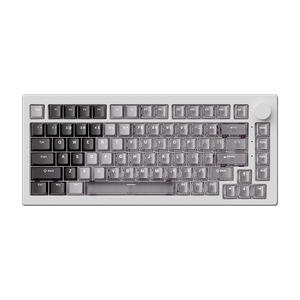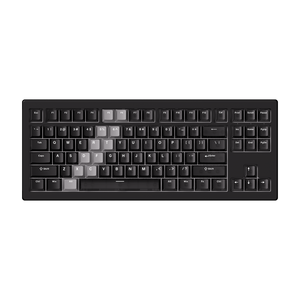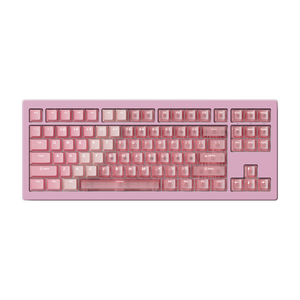What is the Swedish keyboard layout?
The Swedish keyboard layout was designed specifically for typing Swedish. It differs from the US or UK QWERTY layout in terms of key layout and character assignment.
Main features of the Swedish keyboard layout
1. Three additional letters that only occur in Swedish
Swedish has three unique vowels: “Å”, “Ä” and “Ö”, which occupy special positions on the Swedish keyboard.
“Å” is located to the right of the P key, “Ö” and “Ä” are to the right of the L key. This arrangement makes it easier to enter these frequently used letters and corresponds to Swedish spelling habits.

2. Placement of the punctuation keys
The period and colon keys are located on the same key, as are the comma and semicolon.
Some punctuation marks commonly used in Swedish, such as the double ellipsis "..", have their own keys on the keyboard or can be quickly entered using certain key combinations.
The position of some common symbols such as @, ", and / differs from the US keyboard. For example, the @ sign is usually typed with AltGr + 2 instead of Shift + 2 .
3. Support for other Nordic languages
Because Norwegian and Finnish share many letters with Swedish, the Swedish layout is widely used throughout the region, especially in multilingual contexts.
Advantages of the Swedish keyboard layout
1. Efficient input of Swedish special characters
The Swedish keyboard has dedicated keys for the Swedish vowels Å, Ä, and Ö. This allows these characters to be entered directly from the main keyboard without having to resort to complicated key combinations or switching input methods.
For example, on a Swedish keyboard, a simple keystroke is enough to type "Å." On a US keyboard, this often requires combinations like Shift + Alt or other workarounds.
2. Convenient access to symbols
The Swedish layout makes it easy to type frequently used symbols like € (Euro) or § . Furthermore, various letters with accents can be conveniently entered using AltGr combinations .
3. Efficient typing in multiple languages
The Swedish keyboard layout also supports characters from Norwegian, Finnish, and some parts of Danish, making it a versatile choice for users in Scandinavia or anyone who regularly works with multiple Nordic languages.
Swedish keyboard vs. US QWERTY keyboard

1. ISO layout vs. ANSI layout
First, it is important to know that the Swedish keyboard layout follows the ISO layout , while the US QWERTY layout follows the ANSI layout .
This means: The Swedish keyboard has an L-shaped Enter key, a shorter left Shift key and an additional key between Shift and Z.
| element | US ANSI Layout | Swedish ISO layout |
| Enter key | Horizontal rectangle | L-shaped (higher) |
| Left Shift | Full length | Shorter to allow additional key |
| Additional button | No | Between Shift and Z |
| Backslash () | Often via Enter | Relocated or accessible via AltGr |
2. Additional letters: Å, Ä, Ö
These three characters are part of the Swedish alphabet and do not appear on the US keyboard.
| letter | Position on Swedish keyboard | Equivalent on US keyboard |
| Å | Right next to P | Mostly [ or { |
| Ä | Right next to L | Mostly ; or : |
| Ö | To the right of Ä (or L) | Mostly ' or " |
These letters are independent characters , not accented letters, and are used very frequently in Swedish.
3. Differences in symbol placement
Many common symbols are located in different positions or require different key combinations than in the US layout.
| symbol | US QWERTY | Swedish layout | Explanation |
| @ | Shift + 2 | AltGr + 2 | With " exchanged |
| " | Shift + ' | Shift + 2 | Shares key with @ |
| ' | Direct (') | Shift + Ä or AltGr | Different position |
| / | Direct | Shift + 7 | Shift required |
| ? | Shift + / | Shift + - | Other position |
| \ | About Enter | AltGr + < or + | Moved to AltGr level |
| € | Not directly available | AltGr + E | Direct access to euro sign |
| § | Alt + 0167 (Code) | Dedicated button (top left) | Common in EU legal texts |
AltGr (Right Alt key) is used on Swedish keyboards to enter many of these special characters – it essentially acts as a third shift level.
4. Localization vs. Universality
The Swedish keyboard is ideal for localized use in Sweden. The US keyboard, on the other hand, is an international standard and versatile for multilingual input, but requires additional input methods or keyboard shortcuts for non-English characters.
Who should use the Swedish keyboard layout?
The Swedish keyboard layout is specially designed for easy input of the Swedish language and is particularly suitable for the following groups of people:
- Native speakers of Swedish: Indispensable for everyday correspondence and communication.
- Residents of Sweden: Corresponds to the standard keyboard on public computers and locally sold devices.
- Swedish learners: Promotes fluent typing and supports correct spelling.
- Multilingual Nordic users: Convenient for people who live or work in Sweden, Norway, Finland, or Denmark.
- Translators and authors: Makes it easier to write in Swedish.
- Developers in Sweden: Fits local software setups and team standards.
- Keyboard enthusiasts: Offers a unique layout experience with advanced symbol access.
How to change English keyboard to Swedish?
Switching to the Swedish keyboard layout is easy and works on all modern operating systems:
For Windows 10/11:
- Open Settings → Time & Language → Language
- Click Add Language and search for Swedish
- Select it and install the language pack if necessary (optional if only keyboard is needed)
- Click on the added language → Options
- Under “Keyboards” click Add keyboard → Select Swedish
- Now switch between keyboard layouts with Windows + Spacebar
For macOS:
- Open System Preferences → Keyboard
- Click on Input Sources → then on +
- Select Swedish and click Add
- Enable “Show input menu in menu bar” for easy switching
- Switch with Ctrl + Space or customize the keyboard shortcut
For Linux (Ubuntu-based distributions):
- Go to Settings → Region & Language
- Under Input Sources , click on the “+”
- Select Swedish (possibly with variants such as “Swedish (Mac)” or “Swedish (Sweden)”)
- Click on Add and change the layout at the top of the bar
- Optional: Tools like gnome-tweaks offer advanced customization
Optional: Use on-screen keyboard or layout preview
Most systems offer a preview or on-screen keyboard to see where Å , Ä and Ö are located – ideal if you are still using a US keyboard.
Tip for mechanical keyboards
If you are using a programmable or hot-swappable keyboard :
- You can change the key bindings manually using software such as QMK , Via , Karabiner-Elements (macOS) or PowerToys (Windows).
- Or you can install Swedish keycaps for an authentic typing feel.
Conclusion
The Swedish keyboard layout is the ideal choice for anyone who writes in Swedish or works with Nordic languages. It enables a smoother typing experience, better access to special characters, and increased productivity—both in everyday life and in professional settings.















